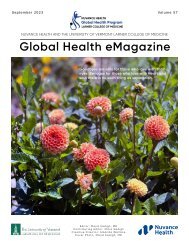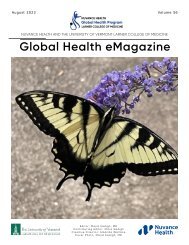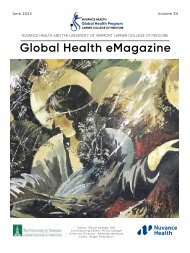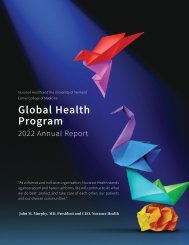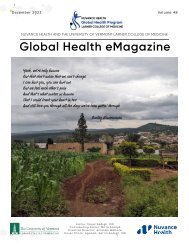eMagazine March 2023
You also want an ePaper? Increase the reach of your titles
YUMPU automatically turns print PDFs into web optimized ePapers that Google loves.
OUR PEOPLE,<br />
OUR MISSION<br />
Global Health<br />
<strong>eMagazine</strong><br />
<strong>March</strong> <strong>2023</strong><br />
Highlights<br />
Reviews<br />
GH Narrative<br />
Reflections<br />
Hispanic and Latinx Voices<br />
Global Local<br />
Voices of Ugandan<br />
Students<br />
Nursing Division<br />
Women’s Health Education<br />
Innovation and Technology<br />
Our Beautiful Planet<br />
Art to Remind Us of Who We<br />
Can Be<br />
Article of the Month<br />
You’re Invited<br />
Photo News<br />
Calendar<br />
Global Health Family<br />
Resources<br />
Previous Issues of<br />
the <strong>eMagazine</strong><br />
Global Local<br />
Health Disparities within our Borders<br />
Section Editor: Ritesh Vidhun<br />
Closure of Rural Hospitals in the United<br />
States; Part 2<br />
Written by Ritesh Vidhun<br />
Even if a hospital has a lower number of patients, one<br />
may think that medical services have high costs and<br />
therefore they should be able to survive. However, in<br />
rural communities many of the patients that utilize a<br />
hospital’s services rely on federal programs. Around 20%<br />
of residents are 65 or older, making them eligible for Medicare, while close to<br />
22% of those under 65 are covered by Medicaid (MACPAC, 2021). Patients under<br />
these programs are still treated with the same level of care as anyone else, but<br />
the payments that hospitals receive are typically lower compared to those with<br />
private insurance. Yet a majority of rural hospital revenue can be attributed to<br />
the government, with approximately half coming from Medicare. This is highly<br />
problematic since reimbursement rates are quite low for these programs–as a<br />
matter of fact in 2020, rural hospitals faced $5.8 billion in Medicare and $1.2<br />
billion in Medicaid underpayments (AHA, 2022). Additionally, rural hospitals are<br />
not able to offset this with private payers like many urban hospitals putting them<br />
at an even greater disadvantage. The lack of consistent revenue makes it nearly<br />
impossible for rural hospitals to flourish leading to such a high number of closures<br />
in past decades.<br />
Given that this issue impacts such a vast number of Americans, lawmakers at the<br />
federal and state levels have proposed unique solutions. These range from bills<br />
to increase funding to entirely revamping the way rural hospitals are designated<br />
by the government. Given that this problem still persists, there has not been a<br />
particular initiative that truly improved the situation.<br />
As the pandemic significantly worsened this issue, federal legislators from states<br />
more affected were quick to propose various bills. The “Save America’s Rural<br />
Hospitals Act of 2021” proposed by Representatives Graves (R-MO-6) and Huffman<br />
(D-CA-2) aimed to reform payment requirements in Medicaid and Medicare<br />
for rural providers. It would suspend Medicare sequestration, adjust bad debt<br />
responsibility from 30% to 15%, extend increased MDH/LVH payments, reauthorize<br />
the Medicare Rural Hospital Flexibility Program, and much more (H.R.6400, 2022).<br />
All changes were focused on alleviating the pressures of Medicare and Medicaid<br />
on rural hospitals in order to increase efficiency. Additionally in September 2021,<br />
the federal government passed a spending bill with a clause that extended<br />
Global Local continued on next page >><br />
23





